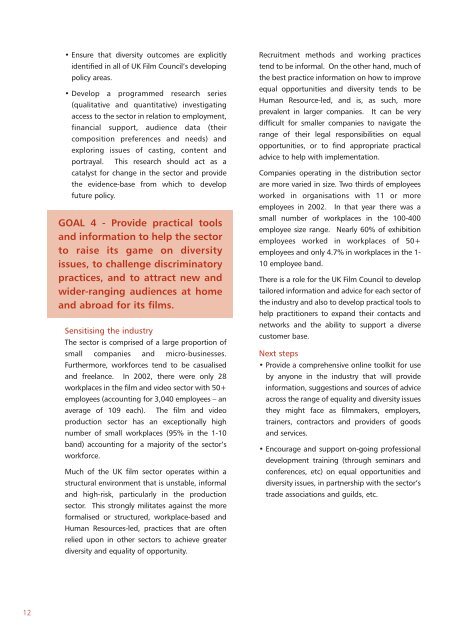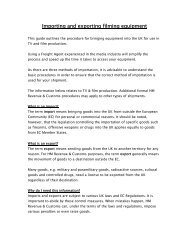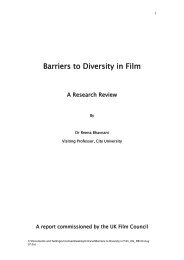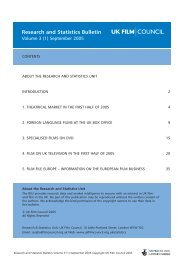Success through diversity and inclusion - BFI - British Film Institute
Success through diversity and inclusion - BFI - British Film Institute
Success through diversity and inclusion - BFI - British Film Institute
You also want an ePaper? Increase the reach of your titles
YUMPU automatically turns print PDFs into web optimized ePapers that Google loves.
12<br />
• Ensure that <strong>diversity</strong> outcomes are explicitly<br />
identified in all of UK <strong>Film</strong> Council’s developing<br />
policy areas.<br />
• Develop a programmed research series<br />
(qualitative <strong>and</strong> quantitative) investigating<br />
access to the sector in relation to employment,<br />
financial support, audience data (their<br />
composition preferences <strong>and</strong> needs) <strong>and</strong><br />
exploring issues of casting, content <strong>and</strong><br />
portrayal. This research should act as a<br />
catalyst for change in the sector <strong>and</strong> provide<br />
the evidence-base from which to develop<br />
future policy.<br />
GOAL 4 - Provide practical tools<br />
<strong>and</strong> information to help the sector<br />
to raise its game on <strong>diversity</strong><br />
issues, to challenge discriminatory<br />
practices, <strong>and</strong> to attract new <strong>and</strong><br />
wider-ranging audiences at home<br />
<strong>and</strong> abroad for its films.<br />
Sensitising the industry<br />
The sector is comprised of a large proportion of<br />
small companies <strong>and</strong> micro-businesses.<br />
Furthermore, workforces tend to be casualised<br />
<strong>and</strong> freelance. In 2002, there were only 28<br />
workplaces in the film <strong>and</strong> video sector with 50+<br />
employees (accounting for 3,040 employees – an<br />
average of 109 each). The film <strong>and</strong> video<br />
production sector has an exceptionally high<br />
number of small workplaces (95% in the 1-10<br />
b<strong>and</strong>) accounting for a majority of the sector’s<br />
workforce.<br />
Much of the UK film sector operates within a<br />
structural environment that is unstable, informal<br />
<strong>and</strong> high-risk, particularly in the production<br />
sector. This strongly militates against the more<br />
formalised or structured, workplace-based <strong>and</strong><br />
Human Resources-led, practices that are often<br />
relied upon in other sectors to achieve greater<br />
<strong>diversity</strong> <strong>and</strong> equality of opportunity.<br />
Recruitment methods <strong>and</strong> working practices<br />
tend to be informal. On the other h<strong>and</strong>, much of<br />
the best practice information on how to improve<br />
equal opportunities <strong>and</strong> <strong>diversity</strong> tends to be<br />
Human Resource-led, <strong>and</strong> is, as such, more<br />
prevalent in larger companies. It can be very<br />
difficult for smaller companies to navigate the<br />
range of their legal responsibilities on equal<br />
opportunities, or to find appropriate practical<br />
advice to help with implementation.<br />
Companies operating in the distribution sector<br />
are more varied in size. Two thirds of employees<br />
worked in organisations with 11 or more<br />
employees in 2002. In that year there was a<br />
small number of workplaces in the 100-400<br />
employee size range. Nearly 60% of exhibition<br />
employees worked in workplaces of 50+<br />
employees <strong>and</strong> only 4.7% in workplaces in the 1-<br />
10 employee b<strong>and</strong>.<br />
There is a role for the UK <strong>Film</strong> Council to develop<br />
tailored information <strong>and</strong> advice for each sector of<br />
the industry <strong>and</strong> also to develop practical tools to<br />
help practitioners to exp<strong>and</strong> their contacts <strong>and</strong><br />
networks <strong>and</strong> the ability to support a diverse<br />
customer base.<br />
Next steps<br />
• Provide a comprehensive online toolkit for use<br />
by anyone in the industry that will provide<br />
information, suggestions <strong>and</strong> sources of advice<br />
across the range of equality <strong>and</strong> <strong>diversity</strong> issues<br />
they might face as filmmakers, employers,<br />
trainers, contractors <strong>and</strong> providers of goods<br />
<strong>and</strong> services.<br />
• Encourage <strong>and</strong> support on-going professional<br />
development training (<strong>through</strong> seminars <strong>and</strong><br />
conferences, etc) on equal opportunities <strong>and</strong><br />
<strong>diversity</strong> issues, in partnership with the sector’s<br />
trade associations <strong>and</strong> guilds, etc.

















